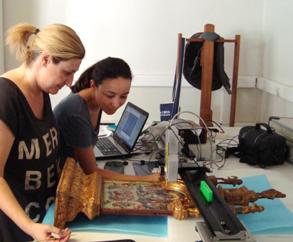
In-situ characterization of pigments in Russian icons, with LMntII portable instument
Laser-induced breakdown spectroscopy (LIBS) and Raman microspectroscopy, based on mobile instrumentation, have been moved to the Byzantine and Christian Museum in Athens (Greece) for the in-situ characterization of pigments in Russian icons. Aim of this study is the identification of pigments in those high artistic quality paintings so as to aid historians to understand the technical background of the icons and conservators to apply the most appropriate conservation treatments. All analyses were performed in the conservation laboratory of the museum, directly on the objects thus eliminating sampling and transportation of the icons.
The analytical investigartion has been performed by the scientists of the Institute of Electronic Structure and Laser, Foundation for Research and Technology-Hellas (IESL-FORTH) :D. Anglos, Z.E. Papliaka, P. Siozos, A. Philippidis.
The campaign was financed by the research project “POLITEIA”(POLitismos-TEchnologIA, New Technologies in the Research, Study, Documentation and Access to the Information for Cultural Heritage Objects and Monuments), Action KRIPIS, project No MIS-448300 (2013SE01380035).
We also greatly appreciate the excellent collaboration with the archaeologist Dr. Nikos Kastrinakis and the conservators of the Byzantine and Christian Museum, Tzeni Perdikari, Maria Filipoussi, Rena Tsivgouli and Sophia Tzavara, as well as the valuable guidance of Dr. Juliana Boycheva from the Institute of Mediterranean studies (IMS) of FORTH.

